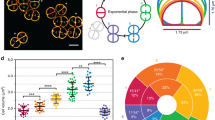Abstract
THE life cycle of the cellular slime mould, Dictyostelium discoideum, can be divided into two mutually exclusive phases1. The vegetative state, in which the cells divide by fission every few hours, is characterised by the absence of intracellular communication; whereas the developmental social state, which is initiated by the exhaustion of nutrients, exhibits many forms of such interactions. These include the ability to respond to and relay chemotactic signals2, and to form stable species-specific cell to cell contacts3–5. The ability to form stable cell contacts can develop in the absence of a chemotactic gradient, as demonstrated by the immediate formation of normal aggregates upon plating of cells which have been maintained in suspension in a nutrient-free salt solution for 8–9 h (ref. 1). New antigens appear and function on the cell surface during development3,4. Gerisch and his coworkers have shown that univalent antibodies directed against the surface of 12 h cell aggregates interfere specifically with the formation of the stable cell to cell contacts4–6. Furthermore, it has been demonstrated that a developmentally controlled, heat-stable component, which is present in membrane preparations from 12 h aggregates, interferes specifically with the morphological and biochemical development of the organism (J.E.S., and J. Tuchman, unpublished, and J. Tuchman et al., unpublished).
This is a preview of subscription content, access via your institution
Access options
Subscribe to this journal
Receive 51 print issues and online access
$199.00 per year
only $3.90 per issue
Buy this article
- Purchase on Springer Link
- Instant access to full article PDF
Prices may be subject to local taxes which are calculated during checkout
Similar content being viewed by others
References
Gerisch, G., Curr. Top. Devl Biol., 3, 157–197 (1968).
Bonner, J. T., Ann. Rev. Microbiol., 75–92 (1971).
Sonneborn, D. R., Sussman, M., and Levine, L., J. Bact., 87, 1321–1325 (1964).
Beug, H., Gerisch, G., Kempff, S., Riedel, V., and Cremer, G., Expl Cell Res., 63, 147–158 (1970).
Beug, H., Katz, F. E., and Gerisch, G., J. Cell Biol., 56, 647–658 (1973).
Beug, H., Katz, F. E., Stein, A., and Gerisch, G., Proc. natn. Acad. Sci. U.S.A., 70, 3150–3154 (1973).
Phillips, D. R., and Morrison, M., Biochemistry, 10, 1766–1771 (1971).
Hubbard, A. L., and Cohn, Z. A., J. Cell Biol., 55, 390–405 (1972).
Hynes, R. O., Proc. natn. Acad. Sci. U.S.A., 70, 3170–3174 (1974).
Watts, D. J., and Ashworth, J. M., Biochem. J., 118, 505–512 (1970).
Firtel, R., and Bonner, J., J. molec. Biol., 66, 339–361 (1972).
Newell, P. C., and Sussman, M., J. biol Chem., 244, 2990–2995 (1969).
Tuchman, J., thesis (California Institute of Technology, 1973).
Raper, K., J. agric. Res., 135–147 (1935).
Newell, P. C., Longlands, M., and Sussman, M., J. molec. Biol., 58, 541–554 (1971).
Studier, F. W., Science, 176, 367–376 (1972).
Laemmli, V. K., Nature, 227, 680–685 (1970).
Author information
Authors and Affiliations
Rights and permissions
About this article
Cite this article
SMART, J., HYNES, R. Developmentally regulated cell surface alterations in Dictyostelium discoideum. Nature 251, 319–321 (1974). https://doi.org/10.1038/251319a0
Received:
Revised:
Issue Date:
DOI: https://doi.org/10.1038/251319a0
Comments
By submitting a comment you agree to abide by our Terms and Community Guidelines. If you find something abusive or that does not comply with our terms or guidelines please flag it as inappropriate.



